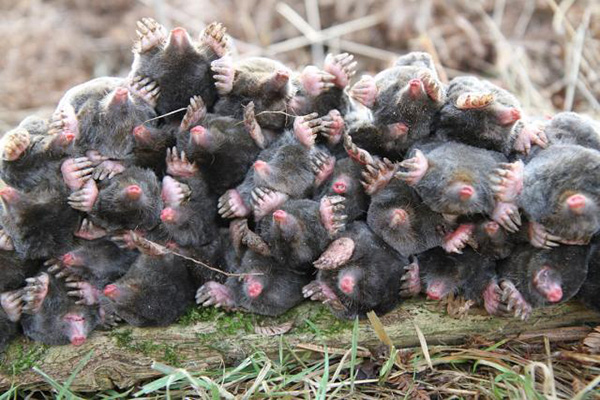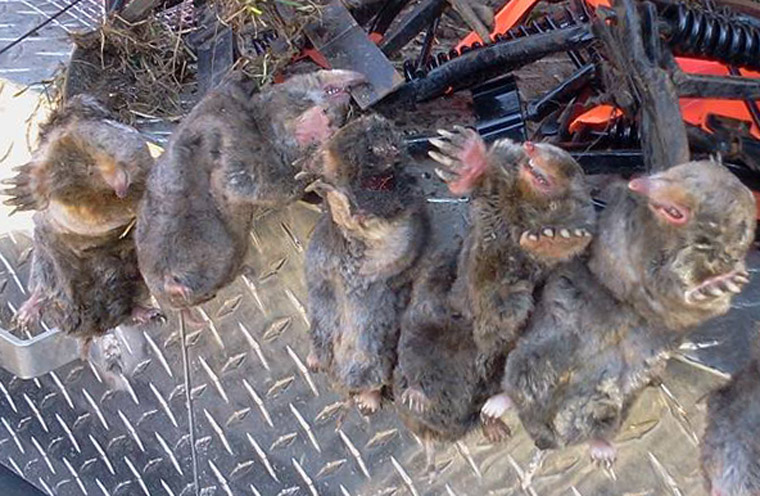- info@wildlife-removal.com
Call us for help in your town
Wildlife Removal Education
How to Kill Moles
Need mole removal in your hometown? We service over 500 USA locations! Click here to hire us in your town and check prices - updated for year 2020.
Click here for a nationwide list of 100's of professional mole trappers serving all 50 states.
To be candid, killing does seem the best and most dependable way to get rid of these poor sighted creatures as most other means of controlling them do not always give the desired result. There are quite a handful of ways to kill moles, but the use of lethal traps and poisons are the most common.
A lot of people talk about getting a shovel or pitchfork and collapsing their tunnels, and killing them in the process. Well, you are hardly going to kill them that way as they are most likely to run away before you can hit them with either garden tool. Shooting is another option commonly used for other nuisance animals like groundhogs and armadillos, but moles are very small compared to these other animals and targeting a mole for shooting could be rather cumbersome. Shooting is therefore not a viable option when you want to kill moles. Below are some of the known effective mole killers:
Mole Poisoning
There is a variety of poisons that can be used to kill moles, each working in its own way. Although moles have poor eyesight, they are not entirely blind and so whatever you are going to use to poison them should have some resemblance to what they would normally eat or else they will not consume the poison. This is why many of the common mole poisons are shaped like worms – one of the mole’s
favorite foods.

- Bromethalin - this is a combination of bromine and fluorine. Shaped like earthworms, bromethalin will cause a convulsive reaction in moles first and eventually result in death.
- Fumigants - fumigants like Fumitoxin are gaseous poisons that effectively eliminate moles. The fumigant is released into active tunnels and allowed to circulate through. Any resident mole that inhales it will be dead in a short while. These chemicals should however be used with great caution as they pose health risks to humans that inhale them as well.
- Warfarin - Warfarin has an anticoagulant effect, which prevents coagulation of the mole’s blood. As a result, the mole starts bleeding internally until it is dead. This gel-like poison also comes in worm shape sometimes.
Note that care must be taken when applying any of these poisons because they do not pose a problem to moles alone, but also to humans and the environment. Residue of poisons can affect soil fertility and cause skin problems for humans if contacted. In extreme cases, some are even capable of killing children and pets.
Lethal trapping
Lethal trapping entails using lethal traps to kill animals. To be successful at this, it is important that the trap be positioned correctly – usually at the entrance of the tunnel. Many lethal traps have been made specially to help eradicate moles, and some of them are detailed below:
- Paper traps - This trap is set inside the tunnel with each side of the clamp sitting with their backs against each other. The mole will inevitably try to pass in between the trap, thereby hitting the pin and triggering the trap. Then the two clamps will come together with the mole in between them. This will result in instant death.
- Scissors trap - Just as the name indicates, this trap features two scissors-like jaws and a trigger pan. Dig a small hole in the middle of the mole's active tunnel and set the trap there with each jaw standing on either side of the hole. The trigger pan will make the jaws come together as soon as the mole passes through the middle and the mole will be killed instantly.
- Spear trap - the Spear trap is to be carefully set over the mole's active tunnel. The spear is its major feature and whenever a mole passes through the part of the tunnel where this trap is, the trap is triggered and the spear will pierce the mole, leading to its death.
Whatever trap type you decide on, you can increase your chances of success by setting more than one trap. Ideally, use one trap for each tunnel observed.
You should find out what your local laws recommend on animal control before proceeding with any of these mole eradication methods. Some states out rightly prohibit using poisons.
For more information, go to may main mole removal page or the How to Get Rid of Moles page.
Ways to Kill Moles
Moles are relatively harmless creatures, when they don't live on your land, of course. They have their good points, turning soil over and allowing for hydration and nutrition to get deeper than it did before with tunneling actions. Moles also eat a lot of worms too, and that stops other worm-eating critters from entering your garden and making a right mess. Moles eat more earthworms than anything else, which stops amphibians, reptiles, birds, and even other opportunistic feeders and scavengers from being able to get their hands on them.

Those mole hills though ... They're enough to drive you mad, aren't they? You’d be forgiven for wanting to kill the animal that keeps digging up your perfect lawn, but killing the animal might not actually be the best way to deal with the problem. There are far too many things that can go wrong.
Let’s say that you use poison …
Before you rush out to buy a whole load of mole poison, you should be aware that the poison can and will effect the soil that you insert it into. It can even contaminate areas further than just your land too. You wouldn’t want to use poison in areas that kids play, or adults hang out in, and you certainly wouldn’t want to use poison anywhere that you let your pets run around. If you are a cat or dog owner and you let your cat or dog go out in the front or back yard, poison is likely to kill them over the creature you're actually trying to kill. Cats and dogs can and will dig up poison, just like they can interfere with traps, and they often come off worse.
Mole poison isn't the easiest thing in the world to get your hands on, although there seems to be a vast array of items on the internet you can buy, as well as a range of homemade concoctions we’ve seen the ingredients too. Buying something off the internet without any knowledge of what you're buying or what is contained within it is a very bad idea. Certain compounds will react with skin and cause blisters or a rash, meaning that specific safety equipment is necessary to administer it. In other cases, with other chemicals and compounds, breathing masks may be essential. You will need to look up the laws in your local area surrounding moles and poisoning them before you take any action. This is even more so the case if you live in areas where certain wildlife species are protected. You would not want one of these protected or endangered creatures to fall victim to your poison, especially if the law were to get involved.
Let’s say that you use traps …
The same problems pop up when you use traps too. You MUST make sure that you use the right trap for the job. A rodent trap will not work on a mole. It won't be big enough for a start, and despite popular belief, moles aren't actually rodents. Mole traps can be expensive, and some of them are quite confusing to figure out too. One wrong move and you could be injured, quite the opposite of the outcome you'd hoped for.
Traps must be placed in the right spots. Deeper tunnels are more frequently used than the ones that are closer to the surface. The higher-up ones are more for temporary use. Male moles will extend their tunneling systems to find a female when it is time to breed, and they can build these temporary, shallower tunnels for this purpose. If this is the case, traps in these tunnels will be a waste of time. They have probably been sealed up at one or both ends, and haven't been used in a long time.
It can sometimes take experience and professional wildlife removal experts a long time to locate commonly used tunnels and underground pathways, so the average homeowner with no knowledge or experience with the animal is not going to have the easiest of rides. When these underground critters don’t want to be captured or spotted, they start un-captured and un-spotted.
Laws
The laws will change from state to state surrounding the killing of moles, and this is the case for a wide range of wild critters too. In almost all places, mole killing is permitted, but this might be under the caveat that certain traps are used, or the moles are only culled at certain times of the year. This is information that you will need to arm yourself with before you start any mole-killing action. The last thing you’d want is to get yourself in trouble over a pesky mole.
Go back to the Mole Removal page, or learn tips to do it yourself with my How to Get Rid of Moles guide.


















